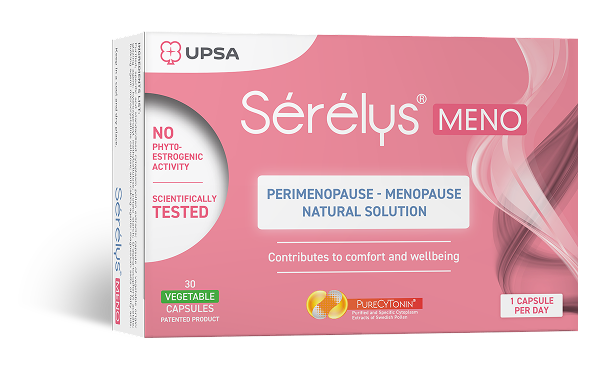
Understanding and identifying menopause symptoms
Menopause symptoms and how to identify them
Understanding your menopause symptoms is the first step to managing them. Caused by the gradual decline in hormones as the ovaries stop producing eggs, although menopause is natural, it can be very uncomfortable. Some common symptoms include menopause hot flushes, menopause joint pain and menopause weight gain.
Women typically experience menopause symptoms in their 40’s and 50’s, although this can vary from person to person. Menopause hot flushes and menopause joint pain can be preceded by other symptoms and changes in your cycle, known as perimenopause.
These irregularities in your cycle can occur months or years before you start experiencing menopause symptoms but can be a good indicator of when to expect menopause to occur. It’s impossible to know exactly when menopause symptoms will start impacting you, especially as some women will never experience menopause weight gain or menopause hot flushes at all!
How women experience menopause varies greatly, you may experience everything listed below, just a couple of symptoms or none at all! Here is a list of common menopause symptoms that you can look out for if you think you’re entering menopausal age.

CHANGES IN YOUR CYCLE
The first menopause symptom women often experience is changes in their cycle. Periods may become longer or shorter, change in their regular pattern and flow may become heavier or lighter.
HOT FLUSHES
Incredibly common in menopausal women, menopause hot flushes are known as a ‘vasomotor symptom’. Hot flushes are also common amongst perimenopausal women and can start before any changes in your cycle. They can last for many years, with frequency ranging from daily to every now and then. Although it may seem like menopause hot flushes happen randomly, they are often triggered by external factors like food, hot drinks and stress and are predominately caused by the changes in the levels of hormones that regulate body temperature.
NIGHT SWEATS
Another common symptom, night sweats are often described as menopause hot flushes that happen during the night. This vasomotor symptom can disrupt your sleep, impacting your health and your mood the following day. These nightly menopause hot flushes can cause women to wake up constantly throughout the night, leaving them feeling totally exhausted the next day.
ANXIETY AND LOW MOOD
These feelings are often caused by the changes in hormones, causing lower moods and reduced overall happiness. Experiencing menopause symptoms generally can impact your wellbeing, as it can be a challenging and confusing time for women. It’s so important to practise self-care during this time, and to ensure you have a strong support system around you to reduce anxiety and stress.
INSOMNIA
Related to menopause hot flushes, insomnia can cause drastic changes in sleeping patterns. Poor quality of sleep can be exacerbated by other menopause symptoms, particularly stress and anxiety. Lack of sleep can create a vicious cycle of tiredness during the day, with menopause hot flushes causing insomnia at night, no matter how tired you are.
IRRITABILITY
Feelings such as this one can be difficult to define and easy to attribute to some other external factor not relating to menopause. It’s important to understand how mental wellbeing can interact with physical menopause symptoms, as each physical symptom can impact your mental state. Acting out of character or saying something you wouldn’t usually say is very normal, and it’s important to be aware that you are not alone!
VAGINAL DRYNESS
One of the least talked-about symptoms, vaginal dryness is caused by a drop in oestrogen. This leads to dryness and irritation that can linger much longer than other menopause symptoms, causing discomfort and often pain for women experiencing it.
LOW LIBIDO
Another one of the most common symptoms experienced during this time is decreased sex drive. With menopause joint pain, menopause weight gain and menopause hot flushes, it’s understandable that women may lose interest in sex during this time. Sex drive can increase with management of other menopause symptoms.
PALPITATIONS
Although these are less common, palpitations still impact many menopausal women. Typically caused by increased stress and anxiety, they are usually not a major cause for concern, however, always seek medical advice if palpitations persist.
WEAK BONES
Lower oestrogen levels cause many menopause symptoms and put women at a higher risk of developing osteoporosis. Women can lose up to 20% of their bone density in the 5-7 years following the menopause. It’s important to stay active and eat a healthy, balanced diet to help maximise bone strength.
RECURRENT UTIs
Another of the more persistent menopause symptoms, recurrent urinary tract infections can occur in menopausal women. UTI’s are identified by the following: needing to make toilet trips suddenly and more often, painful or burning sensations when urinating and changes in urine – cloudiness or the presence of blood. These may be associated with vaginal dryness too.
Menopause joint pain, headaches, reduced muscle mass, general aches and pains and menopause weight gain are all further experiences you may have during menopause. Remember, every woman goes through menopause differently, you may experience all of these, or none at all! It’s important to understand your menopause symptoms. Seek support and advice from a medical professional if ever you feel unsure.
If you’re experiencing menopause symptoms, we have formulated a natural supplement using purified pollen extracts, retaining only the best nutrients. A non-hormonal alternative to traditional menopause medication, Sérélys® Meno is scientifically proven to reduce hot flushes and decrease tiredness.* Lachowsky M. et al., Evaluation of the quality and tolerance of Serelys ® in women during perimenopause and menopause. Genesis, 2015. Volume 183, 10-13.
Maximum efficacy is reached after two months. For lasting effects, continue taking Sérélys for as long as you feel the need.
Live your menopause well, naturally.




